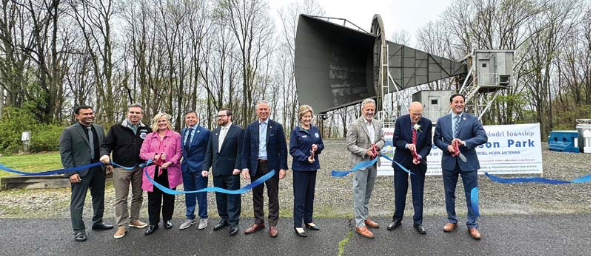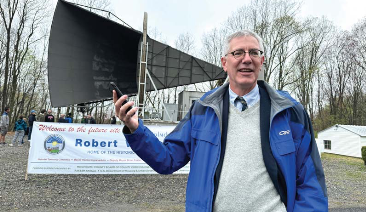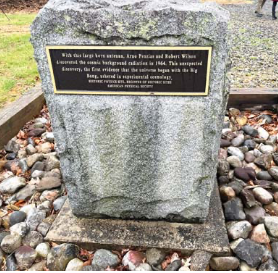
By Sunayana Prabhu
HOLMDEL – Kickstarting Earth Day celebrations, the township held a special ceremony to officially designate the Crawford Hill property of the legendary Holmdel Horn Antenna as the future site of Dr. Robert Wilson Park.
Over a hundred people gathered at the foot of the National Historic Landmark April 20 as Dr. Robert Wilson, a Holmdel resident, joined the ribbon-cutting ceremony for his eponymous park. He was joined by elected officials from the township and county, including Assembly members Gerry Scharfenberger (R-13) and Vicky Flynn (R-13), Monmouth County commissioners Sue Kiley and Ross Licitra, Holmdel Mayor Rocco Impreveduto and Deputy Mayor Brian Foster, committee member Joe Romano and former Holmdel mayor DJ Lucarelli who helped secure the site from development last year.
Impreveduto recognized the Horn’s importance with a proclamation acknowledging the contributions of the community and officials who rallied to preserve the site for a public park. In his address to the gathering atop Monmouth County’s highest peak, Impreveduto noted the “curiosity, knowledge, understanding, the thirst for discovery, embodied in the work of two brilliant young scientists, Dr. Robert Wilson and Dr. Arno Penzias.” Both former Bell Labs scientists won the Nobel Prize in Physics in 1978 for discovering cosmic microwave radiation using the Horn Antenna. The discovery provided the first irrefutable evidence of the Big Bang theory of the universe’s creation. Their discovery transformed the science of cosmology and still guides scientists and researchers worldwide today. Penzias died earlier this year in California.

An archaeologist by profession, Scharfenberger told Wilson, “What you’ve given to future generations in classrooms all around this world is amazing.” Congratulating Monmouth County citizens for their dedication to the Horn’s preservation, Scharfenberger presented a resolution to the township on behalf of the New Jersey Legislature.
“These preserved 35 acres will become a landmark for anyone who wants to quietly walk the trails, learn about the discoveries made here or, in their own way, reach for the stars,” said Impreveduto. “I have never seen this much excitement and engagement in our town. This was truly a community-driven effort.”
Impreveduto acknowledged the “incredible contribution” of over $3.3 million from Monmouth County and the additional $500,000 in federal funding secured by U.S. Rep. Andy Kim (D-3) for the park.
Kiley presented a certificate of recognition to the Holmdel Township Committee. “The Board of County Commissioners congratulates Holmdel Township for their dedication ceremony of Dr. Robert Wilson Park as the preservation of this scientific marvel will ensure future generations the opportunity to learn more about this significant discovery.”
Wilson thanked the township for naming the park in his honor and recognized the efforts of all those involved in preserving and securing the Horn Antenna, including members of FOHOS (Friends of Holmdel Open Space) and CILU (Citizens for Informed Land Use) who actively rallied residents around the idea of creating a park for the antenna. Wilson also acknowledged the former owner of the property, Rakesh Antala of Crawford Hill LLC, for maintaining the property and allowing his astronomy class from Harvard University access to the site once a year to take real measurements using the antenna. He also thanked Greg Wright, “who has looked after the Horn since I retired from Bell Labs.”

Wilson gave attendees a short lesson about the milieu and how Bell Labs pioneered radio astronomy and cosmology work in the 1950s and 1960s using inventions like the Horn Antenna and Echo satellite.
Experiments with the Horn Antenna began in 1933 when Karl Guthe Jansky, known as the father of radio astronomy, then a young engineer with Bell Laboratories, “announced here in Holmdel that he had received radio waves from the center of our Milky Way galaxy. This was the beginning of radio astronomy,” Wilson said.
After studying at Caltech, Wilson said he felt “very lucky” to have started his career
in Bell Labs in 1963 and, along with Penzias, to use the horn antenna for unique radio astronomy projects. “One might ask why did Bell Labs hire two radio astronomy research. They hired Wilson and Penzias specifically because, as radio astronomers, they would know how to make good use of its capabilities for astronomy projects in ways others could not.
The “upper management” at Bell Labs was told that radio astronomers would be “very useful with satellite communications” because they understood atmospheric and outer space signals.
“When I entered the workforce, the nation, perhaps shocked by Sputnik and remembering the contributions to winning World War II, understood the value of science for its future,” said Wilson. After World War II, the United States was “willing to spend money” to be the world leader in these fields. The launch of Sputnik by the Soviet Union in 1957 heightened American priorities around science and space technology as part of the broader Cold War.
During their work, Wilson and Penzias noticed the horn antenna was picking up excess noise that couldn’t be explained. After months of investigation, a conversation with a team of Princeton University researchers, including physicist Robert Dicke, led Wilson and Penzias to realize their findings matched predictions for cosmic microwave background radiation from the Big Bang.
“It has been a wonderful ride,” Wilson said.
The township is now developing a plan for the park after a yearlong negotiation with Antala for ownership of the property. In a conversation with The Two River Times before the event, Wilson said he hoped the antenna is “set up in a way that it can be maintained” in the future. “I think we should have some nice weatherproof signs explaining what happened,” he said. Wilson is in favor of “setting up a whole education center and museum” on the site.
Antala still owns the former Nokia Bell Labs building at the foot of the Crawford Hill property; it is being considered as a space for innovation. “The idea we are looking at is to convert that (former Nokia building) into an incubation lab where we can bring the whole ecosystem of startups,” he said. Antala said he is in initial talks with certain state departments and the governor’s office to bring momentum to the initiative.
Ralph Blumenthal, a resident who rallied to preserve the site and the antenna, floated the idea of a park like the new Edelman Fossil Park and Museum at Rowan University. Opening soon, the park is pegged as a “time-traveling adventure through history.”
“A lot of progress has been made (but) some of us have a bigger vision for what can be done here. And it’s going to take time to get the committee on board to create what could be an incredibly great park here,” Blumenthal said.
A plaque recognizing the historic landmark offers inspiration to people worldwide who make the pilgrimage to Crawford Hill: “With this large Horn Antenna, Arno Penzias and Robert Wilson discovered the cosmic background radiation in 1964. This unexpected discovery, the first evidence that the universe began with the Big Bang, ushered in experimental cosmology.”
The article originally appeared in the April 25 – May 1, 2024 print edition of The Two River Times.














